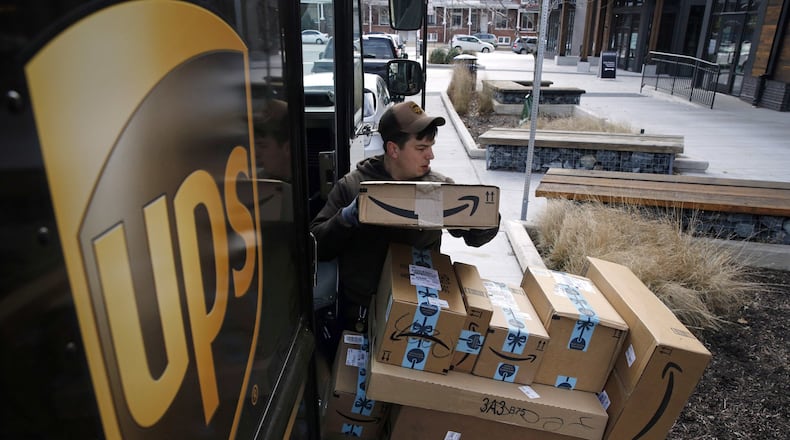Editor’s note: This article has been updated with additional details, including interviews with unemployed workers experiencing delays in benefits. The article has also been modified to reflect a revision in some of the numbers released by the Department of Labor.
Georgia’s unemployment rate dropped last month to 9.7% from an all-time high of 12.6% in April, spurring hope that the economy has started to recover from massive job losses triggered by the coronavirus pandemic.
The state added 79,600 jobs in May, according to the Georgia Department of Labor. [The department originally said 94,300 jobs were added, but issued a revised release on Friday.]
While other measures show uneven gains thus far, there's reason to believe the numbers will keep improving, according to Labor Commissioner Mark Butler.
"We have to remember that the recent unemployment was not caused by an economic catalyst, but instead by a medical emergency," he said. "Those jobs are still out there for the most part."
After tripling in April, the national jobless rate also fell in May, dropping from 14.7% to 13.3%, according to the Bureau of Labor Statistics.
Some experts have said the optimism must be tempered, partly for statistical reasons. The number of unemployed does not include those who have dropped out of the labor force and many who believe their job loss is a temporary furlough.
Cortera, a company that tracks business spending, has not yet seen a turnaround in Georgia, said Jim Swift, chief executive officer.
“To me, the key is how fast is manufacturing going to go back up, because once that engine starts going, then everything else starts going,” he said.
Spending at Georgia manufacturers is 24% below that of a year ago, Swift said. "It looks like we are nearing the bottom of this thing. We are still declining, but the rate of descent is slowing."
Moreover, even if the economy is starting to dig out, the hole is very deep. The number of employed Georgians was down 480,592 from May of 2019. Last week, the state Department of Labor processed 131,997 initial jobless claims. Payments are being delayed as Georgia struggles to keep up with 2.5 million claims since mid-March.
Economists say a full recovery depends on a return of demand from consumers, who account for more than two-thirds of spending. And if consumers do not feel comfortable spending – especially at restaurants, stores or on travel — the companies that hire may find themselves overstaffed.
Most of the damage continues to be among workers whose jobs depended on contact or on consumer spending that has been chilled by the coronavirus, said Atlanta-based Michelle Jones, chief external affairs officer at Money Management International, a network of non-profit agencies that offer financial counseling.
“From what we are seeing, there is a disproportionate impact on lower income, hourly and/or gig economy employees,” she said.
However, the many components of the economy do not move in lockstep.
Staffing companies are often the first to see the economy change directions, and they are seeing an uptick, said Irma Shrivastava, chief marketing officer at Atlanta-based Randstad USA.
The company in the past several weeks has seen more demand in manufacturing, finance and tech work.
Some of the slots are new kinds of jobs, she said. “Contact tracers – who knew that even existed?”
In tech, much of the hiring has been for engineers who can help make a business more efficient. Even in healthcare, the need is more about information than front line workers, she said. “The dentists’ offices are open, but how comfortable do you and I feel to have a cleaning done?”
Many jobs also depend on a larger return to business as usual.
For instance, Troy Sniff, 55, of Calhoun, has been a graphics operator for television sports, like the Hawks, Braves and Predators. When professional sports shut down, so did his work and he filed for unemployment.
“My work does not return until all of sports returns to normal,” he said.
And like many, he’s still waiting to be paid unemployment benefits, money he said he needs for family and bills.
About 700,000 Georgians are currently eligible to receive payments. But many who have been approved have been waiting weeks or even months for their weekly payment as state officials struggle to catch up with the unprecedented flood of job cuts. Adding to the backlog are thousands of workers who were made eligible by federal laws passed to ease the crisis.
Many phone calls and emails to DOL staff simply went unanswered.
Elaine Harris, 59, of College Park, started a new job as a tax accountant in early March. When the pandemic hit, she was furloughed at first, then laid off at the end of April.
She called all sorts of government officials, looking for help. She tried the county's board of commissioners and they gave her numbers for DOL officials, then told her they'd had no better luck than she had at getting an answer.
“That was not reassuring at all,” Harris said.
Payment finally came through at the end of last week, she said. “If it had gotten to the end of June with no money, I would have been very concerned.”
Unemployment rate in Georgia
January: 3.1%
February: 3.1%
March: 4.6%
April: 12.6%
May: 9.7%
Sources: Georgia Department of Labor, Bureau of Labor Statistics
Georgia’s new jobless claims since end of shelter in place
Week ending:
May 2: 228,352
May 9: 242,772
May 16: 177,731
May 23: 165,499
May 30: 149,163
June 6: 131,997
Sources: Georgia Department of Labor, U.S. Employment and Training Administration
The Georgia economy’s pandemic divide
Industries doing better than a year ago:
— Building materials and garden supplies
— Couriers and messengers
— Electrical equipment, appliance manufacturing
— Transportation equipment manufacturing
Industries doing worse than a year ago:
— Motor vehicle and parts dealers
— Chemical manufacturing
— Construction
— Paper manufacturing
Source: Cortera
About the Author
Keep Reading
The Latest
Featured


